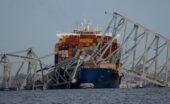Molly Minturn - My family is heartbroken to share that my father died in surgery on Monday, Feb. 10. It…
Wednesday Night #1176 – Aviation (with 2007 updates)
Written by Diana Thebaud Nicholson // September 15, 2004 // Aviation & Aerospace, Environment & Energy, Reports, Wednesday Nights // Comments Off on Wednesday Night #1176 – Aviation (with 2007 updates)
9/11 Anniversary
The past weekend was filled with anniversary stories of the tragedy of September 11, 2001 , while CBC reminded viewers of the Swissair disaster at Peggy’s Cove on September 2, 1998.
Regarding 9/11, our attention has been called to the video that reports the puzzling discrepancy between the size of the Pentagon area damaged by the Boeing 757 and the actual size of the aircraft.
“NOTE: The absence of a 100 ft. crater on the front lawn. For reference, the hole that you see on the front of the Pentagon is only about 65 ft. wide. Where is a hole large enough to accommodate an airplane which is 124 ft. wide and 44 ft. tall? Where is the Boeing 757 wreckage? What happened to the passengers?” Does anyone have an answer?
The plight of airlines
On Sunday, US Airways filed for bankruptcy protection joining United Airlines in bankruptcy. It is predicted that Delta could soon follow.
On several recent Wednesday Nights, there has been lively discussion of Oil and oil depletion with a number of Wednesday Nighters questioning the effect of the latter on aviation – not only air travel, but also air cargo, the silent servant of our needs for instant gratification (urgent messages, spare parts, perishables) or aid for devastated areas.
Canadians back Kyoto
The Gazette reports the findings of a Government-Commissioned poll. Support for gas-reduction agreement rises steadily, even in Alberta.
Concurrent news of the devastation wreaked by Hurricane Ivan gives the lie to the doubters who persist in asking ‘what climate change?’.
In an accompanying column, Peter Hadekel of the Gazette highlights Quebec’s plans to protect the environment “without hurting the economy”. He says that Environment Minister Tom Mulcair is expected to publish a Green Plan that would put all arms of [the provincial] government on the same page as far as sustainable development is concerned, and also intends to publish a strategy on biodiversity that would bind government departments.
News and conjecture regarding the overhaul of Canada’s Healthcare. We might ask if it is wise to have gavel-to-gavel coverage of this week’s meeting in Ottawa. Does not the presence of the media influence what is said; isn’t everyone playing to the audience back home?
Should the discussion on these topics wane, there is much, much more fodder for the intellectual appetite, including the on-going tragedy in Sudan (was the U.S. Administration right to label it ‘genocide’?), the disappointing results of the Hong Kong elections, renewed violence in Iraq and Afghanistan, and the latest on the U.S. presidential race.
The Report
A Who’s Who in aviation
In honour of the first visit by Dr. Triant Flouris, Director of the Concordia International Aviation MBA (IAMBA) programme an impressive range of aviation-related expertise was gathered around the table. Notable among those who contributed to the wide-ranging discussion of aviation-related issues were: Louise Roy, Associate Fellow, specialized in leadership and governance issues at Cirano and previously Vice President Marketing and commercial services of IATA, and Vice President for North America of Air France; Me Gilles Gagné, Chair of the Air and Space Law Section of the Canadian Bar Association; Me Claire Panet-Raymond who served as legal counsel of IATA; Henri Castillo former executive of KLM and Air France; Anthony Philbin who has been a principal collaborator on three editions of the Compendium of International Civil Aviation, and has worked on numerous projects with IATA and ICAO; Wanda Potrykus, former North American spokesperson for IATA; Dr. Judith Patterson, who has most recently co-authored a paper on the depletion of oil reserves and their impact on aviation; James Greenhill, an insurance risk management specialist who has an MBA from McGill and maintains his pilot’s license; Prof. Karl Moore of the McGill Faculty of Management, who is a frequent commentator on aviation matters; and Melanie Lauckner who manages the Simplified Passenger Travel (SPT) dossier at IATA.
I have never had this kind of brains trust in one room – even at conferences – with the breadth of knowledge of every aspect of aviation
“In plane sight?”
The video which has recently circulated on the Internet, provoked considerable discussion regarding the damage done/not done to the Pentagon on 9/11. The size of the hole that pierced the building which does not match the footprint of the plane, the lack of fire or smoke damage, the lack of plane and body parts are all suspicious and these are compounded by the absence of the expected video surveillance from Pentagon cameras. Although accident investigation would analyze the degree of control the plane still had, and the angle of impact, – a steep angle would result in a small crater with little debris -, the video footage showing a book open on a desk and with no sign of fire damage, adjacent to the gaping hole purportedly made by a plane fully loaded with jet fuel, leaves many unanswered questions.
[Editor’s Update: Although not usually among our references, we eventually turned to the excellent, factual Popular Mechanics “Debunking the 9/11 Myths: Special Report ” for answers]
Is it possible that the plane in question was pursued and shot down at sea by one or more US Air Force fighters? Although the reports have always stated that the military planes at Andrews AFB were not scrambled, there might have been one or more planes already in the air. But then, where did the damage to the Pentagon come from?
It was asked if there was a standing policy that if a plane is off course even for a few minutes the USAF will scramble its F16 and F18 planes in 15 minutes. From Andrews Air Force base it is only a couple of minutes flying time to the Pentagon and the other federal buildings in the Washington area. The fact this did not happen on 9/11 is curious. A possible explanation is that over the years prior to 9/11, the US and its military systems which were designed to fight the cold war, did not have standing orders to cover events such as 9/11.
The IAMBA
Many of the students in the programme are sent by their employers (airlines, air navigation services, manufacturers, aviation departments of governments) and therefore are guaranteed jobs when they graduate. However, the current precarious financial situation of airlines is reflected in the low number of students, particularly from the developed world. IATA is no longer a partner, despite the fact that the concept originated with Pierre Jeanniot, the former Director General of IATA. The rupture was due in part to the tension between the university’s desire to maintain standards by insisting on high academic qualifications for the professors, and industry which offered instructors with years of practical experience.
While universities are not trade schools and the theory, analysis and discussion are considered very important, unlike the programme offered by McGill’s Institute of Air & Space Law, real experience might well be the better foundation for the IAMBA programme.
Among other suggestions was one that recommended that IAMBA students be exposed to labour leaders who could come to the programme to discuss the negotiation process – an inevitable part of aviation management today.
Air Canada and survival of national airlines
One observer who had recently spent an hour with Robert Milton, the CEO, expressed a guardedly optimistic view on Air Canada in the belief that Milton’s plan to let smaller airlines feed the Air Canada long haul and overseas flights should work in the long run.
[Editor’s Note: On September 27, Air Canada announced a purchase from Bombardier of 15 74-seat Bombardier CRJ700s and 15 CRJ200s, a 50-seat model. The aircraft will be operated by Air Canada’s regional airline subsidiary, Air Canada Jazz, on short- and medium-haul North American routes.]
Others disagreed, stating that most major (“legacy”) airlines in North America are in Chapter 11 or equivalent, the most recent case being US Airways this past weekend. There is considerable over-capacity worldwide. In Europe, Air France and KLM have merged, and the expectation is that the KLM branding will disappear. [Editor’s update – we were wrong. Three years later the Air France-KLM Group is flourishing and both airlines continue to operate under their distinct names.] What may remain are the brands such as Star Alliance, to which Air Canada belongs.
However, KLM and other flag carriers may survive because of their respective government’s support for national identity. An important point raised is that it is the governments that have the landing rights and slots based on bi-lateral agreements and generally the national carrier has the pick of the lot. These are precious commodities and rights that governments will protect.
One recipe for success is the combination of WestJet for low-cost North American operations with Cathay Pacific trans-Pacific service into Hong Kong [Editor’s Update: this didn’t happen; it’s still being discussed three years later.] Passengers with WestJet are impressed by the high morale of the staff and real customer focus. The exact opposite is the case at Air Canada where labour negotiations are a constant problem. While Air Canada has high standards for its maintenance facility in Winnipeg, its costs are equally high.
Aviation and the environment
Some 15 years ago it was thought that planes did cause problems with the distribution of pollutants (such as NOx and CFCs). However, aviation is now considered a small contributor in the overall scheme of things. The Montreal Protocol (on Substances That Deplete the Ozone Layer) on CFCs is working and the hole in the ozone layer is diminishing and repairing itself. On the other hand, there are still no conclusions regarding the behaviour and effect of greenhouse gases emitted at high altitudes.
Alternative aircraft? Anything with a dramatic impact is 10-15 years away at best. The most important factor to consider today is that there is no more cheap oil; we are on the flat part of the cost curve; the pollution process is self-limiting.
As on several previous evenings, it was pointed out that aviation is one industry where alternate fuel sources will most likely not be successful. A plane, such as the Airbus 340 can fly for over 15 hours halfway round the world with some 300 passengers. Solar, nuclear or wind power cannot compete in this arena.
The introduction of the A-380
The Airbus A-380 will seat 555 passengers in a double-decker configuration. Singapore Airlines is the launch customer, followed by Emirates. Air France is going to fly one to Montreal as early as 2007. Is there really a market for these behemoths? Yes, some markets are under-served and the capacity of the planes will compensate for slot restrictions. However it appears that some airlines that have been induced to order them are still not sure how they will use them.
Are Airports ready?
Will the airports be ready to receive the plane? While some say yes, it is doubtful that most airport authorities have given the matter as much thought as they should. A critical aspect of the introduction of the A-380 is the strain that the size will place on airport infrastructures,- can the runways bear the weight? Taxiways will have to be widened so that outboard jets will not burn the grass or ingest dirt, debris, or desert sand in places like Dubai – not incidentally the first airport to be certified for the A-380. Gates, loading bridges, baggage systems and carousels, security and customs inspection facilities, check-in counters and queuing areas – all will require costly modifications. In Europe the EU will subsidize the infrastructure costs to support the Airbus industry which is spread across many European countries. But elsewhere, the airlines … ergo the passenger … will be charged accordingly by the airport authorities (we are already used to the oxymoronic ‘airport improvement’ charge).
[Editor’s note: there is a highly cost-effective solution to the problem of widening runways, taxiways and apron areas, but the airport authorities are slow to accept a solution to a problem they haven’t admitted they have. More on this topic soon from Eric McConnachie]
All of this debate reminds us of the wisdom of the governing planning principle at Mirabel Airport where each element could be expanded without impact on the others. [Editor’s updates: it has been announced that poor Mirabel is now to be turned into an amusement park, with no guarantee that this scheme has a particularly reliable business plan!]
Insurance
And what about insurance liability – what happens when an A-380 crashes with 555 people on board? Insurance is not expected to be a problem as it is underwritten by several companies to spread the risk.
Travel agents – are they disappearing?
The low-cost carriers have marketed directly to the public; and the airlines have made the fare structure less complicated and more accessible to the public. With most airlines using the Web for online bookings, and also shrinking the commission paid to travel agents, this important segment of the travel industry has to downsize. However, while online booking works well for the simple one-destination trip, anyone trying to plan a complicated itinerary finds that it is impossible to do the booking online and that many of the agents that can be reached through the online service are less than helpful (some don’t seem to have passed Geography 101!). The good travel agent offers a valuable service and should be supported by the airlines through such actions as making travel agents the medium for obtaining secure travel documents.
The aircraft industry
At the other end of the spectrum, Paul Tellier of Bombardier is facing a $2 billion decision as to whether they should build a new aircraft for the 100 – 130 passenger market. Given the current over capacity and aviation market situation, this is a difficult one to call.
Notes by Gerald Ratzer
Edited by Diana Thébaud Nicholson



